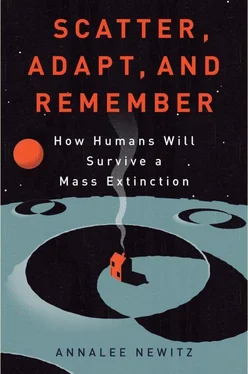For all these reasons and more, it’s likely that the project of exploring space will involve a parallel project to adapt our bodies to life in environments radically different from the one where we evolved. It’s possible that we’ll become cyborgs, beings who are half biological and half machine. We may tweak our genomes to be radiation-resistant. Or we may, according to some futurists, become so technologically advanced that we’ll be able to convert the galaxy into a giant version of Earth. No matter what happens, the humans who live in space will be different from the humans on Earth today.
Changing Ourselves to Live in Space
How would we go about modifying ourselves to be more space-worthy? If anyone would know, it would be a synthetic biologist. In chapter 18, we explored how synthetic biology could revolutionize cities by providing us with buildings that could heal themselves or even grow. The field has obvious applications for any project to create humans suited for life beyond Earth as well. Leaving aside for a moment the ethical issues of engineering space-ready humans, synthetic biology could eventually reach a point where we could accurately predict how modified human genomes would function—and then implant them in the next generation. Though such knowledge may be centuries away, it’s very possible we might one day be guiding ourselves through a phase of evolution aimed at, for example, giving birth to children who could live on Mars unharmed.
To find out how this might work, I visited the UC Berkeley synthetic biologist Chris Anderson, a pioneer in the field whose research focuses in part on defining the most efficient and ethical methods for pursuing synthetic biology. A slender man with a sly smile, Anderson launched into an explanation of the future direction for synbio (as it is fondly known) by first seizing a piece of putty on his desk and vigorously smashing it between his hands. “I love this stuff!” he enthused. Apparently there is a reason the substance is sometimes marketed as “thinking putty,” because Anderson’s train of thought matched the pace at which he mashed out different shapes, which each looked like a new phylum of bacteria. Synbio researchers, he said, look at every organism in terms of its component parts. They don’t want to engineer new life-forms—not exactly. Instead, they want to engineer parts, especially at the genetic level. “Fundamentally, what we’re talking about is moving genes between organisms,” Anderson said. “We want to write whole genomes eventually. But it’s all based on components, and having the ability to predict how they will add together.”
A synbiologist looks at life-forms the same way a mechanic looks at an engine. To the mechanic, the engine is a set of interoperable parts, and some of those parts could just as easily be used in another machine. Likewise, a biological part like a gene or a protein could easily be repurposed for use in another organism. In fact, Anderson pointed out, a synbio project would typically look at a particular part—a gene, for example—in its many variants across a thousand organisms. Let’s say a synthetic biologist is studying a gene that thousands of plants use in photosynthesis. Her goal in that research would be to predict how the gene would function if it were used as a part in another organism. She would base her predictions on how the gene behaved in the thousand species where it currently exists. “This is a paradigm shift,” Anderson said. “We’ve stopped focusing on studying naturally existing things and are instead building things one gene at a time. Basically, it’s biological systems as a sum of their parts.”
Anderson’s work focuses on bacteria, and when I started to ask about modifying humans he wrinkled his nose. “I don’t touch mammalian cells,” he quipped. “They’re such a mess.” And this messiness is nothing compared with the moral quandaries presented by a future where we might use synbio to make Martians. The main problem, he said, is that we can’t experiment on humans the way we do with bacteria. To make accurate predictions about what a gene will do in a given organism, you have to run thousands of tests—some of which reveal that the gene does the opposite of what you’d hoped. “If you are playing with enhancing human intelligence, for example, you might create somebody who is brain dead rather than smart,” Anderson mused. “There would be so many accidents because this work involves a lot of fundamental uncertainty.”
Given all the risks and their consequences, he added, “It’s hard for me to see how you could even develop enough design theory to be able to safely build a human. It’s not going to be socially acceptable to tweak a human in a way that could cause them to be born grossly broken. No one’s going to go for that.” But, he conceded, it might be possible in a future where we had “a radical transformation in our ability to predict things” on the genetic level. If we had absolute certainty about how a given gene would work in a human, then the risks would be minimal. However, Anderson was extremely dubious we’d ever reach this point. He emphasized several times that he couldn’t believe that humans would ever be willing to modify our germ lines to change our species at a genetic level.
His sentiments were echoed by Claudia Wiese, a Lawrence Berkeley Lab geneticist who studies how humans respond at a cellular level to radiation in space. “During a long-duration manned space flight, substantial numbers of cells in a human body, [approximately] 30%, will be traversed by at least one highly ionizing particle track,” she told me via e-mail. “Highly ionizing particles” are the most dangerous kind of radiation we can encounter in space—these energetic particles shoot through the body like infinitesimally small bullets, cutting through everything in their path, including tissues and DNA. The danger is that they would damage a cell’s DNA but not kill the cell outright. Subsequently, the cell would replicate with mutated DNA, a situation that can lead to cancer.
Wiese and her colleagues believe some variants of DNA-repair genes may be better at dealing with radiation damage than others, but they’re nowhere near being able to tweak these genes to make humans radiation-proof. “I think that we are a long way away from gene therapy,” Wiese said. “At this point, the use of appropriate countermeasures”—like drugs such as antioxidants—“may be a more immediate and feasible way to mitigate the detrimental effects of space radiation.” Still, her research and that of other geneticists working with NASA suggest that we may one day know which genes control DNA repair. Once we are able to predict the behaviors of these genes, future space-farers might tweak their genes to respond quickly and effectively when bombarded with highly ionizing particles beyond Earth’s protective magnetic envelope.
But some synbio researchers aren’t sure this is a good idea. Daisy Ginsberg, a London designer who works with synthetic biologists on the ethical implications of their work, said that we could take the modification of humanity way too far. Sipping tea in a London restaurant, Ginsberg’s sunny disposition belied a deep pessimism. “I’m of the mind that we’re going to fuck everything up,” she said cheerfully. “We’re going to poison the Earth and it’s going to be unpleasant and expensive. I think we’re going to become Morlocks.” Ginsberg was referring to H. G. Wells’s novel The Time Machine, in which the author predicts that humans will evolve into two species: the Morlocks, a hyper-technological, warlike group who live underground, and the Eloi, a dim-witted but peaceful group who are prey to the Morlocks. Ginsberg was basically predicting that humans would evolve to be hideous monsters who destroy the Earth and prey upon each other. But what about modifying ourselves to live beyond Earth, so that we stop destroying our home world? Ginsberg was dubious about that, too. “I think it’s unethical to colonize space because we’ll make a mess there as well,” she said. “I’m sure we’ll be modifying everything.”
Читать дальше






![Аннали Ньюиц - Автономность [litres]](/books/424681/annali-nyuic-avtonomnost-litres-thumb.webp)





